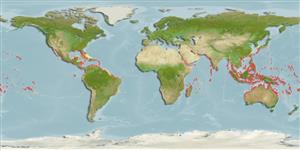Common names from other countries
>
Syngnathiformes (Pipefishes and seahorses) >
Syngnathidae (Pipefishes and seahorses) > Nerophinae
Etymology: Microphis: Greek, mikros = small + greek, ophis = serpent (Ref. 45335).
More on author: Bleeker.
Environment: milieu / climate zone / depth range / distribution range
Ecología
marino; agua dulce; salobre demersal; anadromo (Ref. 51243); rango de profundidad 0 - 5 m (Ref. 86942). Subtropical; 35°N - 32°S
Asia and Oceania: Sri Lanka, southern India, Nicobar Islands and eastward to Japan and the Society Islands. Records from Puerto Rico and USA need confirmation. Africa: east coast from Kenya south to KwaZulu-Natal area, also Madagascar and Mauritius (Ref. 7248, 52193). Africa: Côte d'Ivoire (Ref. 272). Western Atlantic: Atlantic coast of Florida, Bahamas, northern and southern Gulf of Mexico, Antilles, central and south American coasts to Brazil (Ref. 26938).
Length at first maturity / Tamaño / Peso / Age
Maturity: Lm ?, range 12 - ? cm
Max length : 22.0 cm SL macho / no sexado; (Ref. 5316)
Espinas dorsales (total) : 0; Radios blandos dorsales (total) : 37 - 54; Espinas anales: 0; Radios blandos anales: 4.
Occurs in relatively shallow (25-150 cm), still to slow-flowing water (Ref. 6028). Inhabits freshwater streams, rivers and estuaries. Juveniles and subadults are usually found in estuaries while adults are found upstream in freshwater areas. Feeds on worms, crustaceans and zooplankton. Ovoviviparous (Ref. 205). The male carries the eggs in a brood pouch which is found under the tail (Ref. 205). Not seen in markets (Ref. 12693)
Female deposits eggs on the ventral surface of the male trunk's or tail , where they are incubated for several weeks. Males may be brooding at 12 cm SL (Ref. 5316).
Dawson, C.E., 1985. Indo-Pacific pipefishes (Red Sea to the Americas). The Gulf Coast Research Laboratory Ocean Springs, Mississippi, USA. (Ref. 5316)
IUCN Red List Status (Ref. 130435)
CITES (Ref. 128078)
Not Evaluated
Threat to humans
Harmless
Human uses
Pesquerías: sin interés; Acuario: Comercial
Herramientas
Special reports
Download XML
Fuentes de Internet
Estimates based on models
Preferred temperature (Ref.
115969): 25.4 - 29.2, mean 28.1 (based on 3402 cells).
Phylogenetic diversity index (Ref.
82804): PD
50 = 0.5000 [Uniqueness, from 0.5 = low to 2.0 = high].
Bayesian length-weight: a=0.00085 (0.00032 - 0.00224), b=3.04 (2.81 - 3.27), in cm Total Length, based on LWR estimates for this (Sub)family-body shape (Ref.
93245).
Nivel trófico (Ref.
69278): 3.3 ±0.41 se; based on food items.
Resiliencia (Ref.
120179): Alto, población duplicada en un tiempo mínimo inferior a 15 meses (Preliminary K or Fecundity.).
Fishing Vulnerability (Ref.
59153): Low vulnerability (17 of 100).
